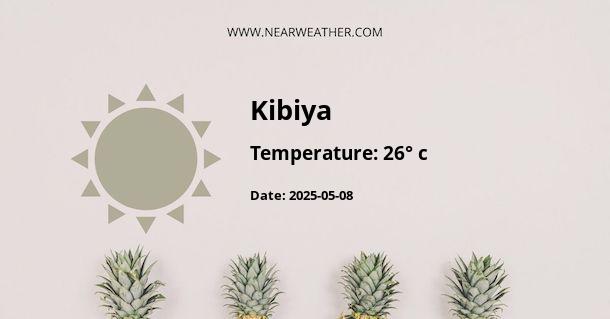Weather
26° 
Climate Conditions: overcast clouds
Humidity: 24%
Wind speed: 5.72 km/h
Wind direction: 181°
Daily Weather Forecast
Thursday
05/08/2025
Climate Conditions: clear sky
Humidity: 25%
Friday
05/09/2025
Climate Conditions: clear sky
Humidity: 8%
Saturday
05/10/2025
Climate Conditions: clear sky
Humidity: 8%
Sunday
05/11/2025
Climate Conditions: clear sky
Humidity: 8%
Monday
05/12/2025
Climate Conditions: broken clouds
Humidity: 25%
Tuesday
05/13/2025
Climate Conditions: few clouds
Humidity: 23%
Evolution
Daily Weather Forecast Evolution (°C)
Lowest temperature
Highest temperature
Other Information
Sunrise
06:03
Sunset
18:39
Latitude
11.526290
Longitude
8.662270
Timezone: GMT+05:30
More about Kibiya:
Climate and Weather in Kibiya, Nigeria: A Year-Round Overview
Kibiya is a town located in the Kano State of Nigeria. As with many regions in Nigeria, Kibiya experiences a tropical savanna climate, characterized by distinct wet and dry seasons throughout the year. In this article, we will provide a detailed overview of the climate and weather patterns in Kibiya, highlighting the temperature, precipitation, and other important climatic factors.Temperature
Kibiya, like many other parts of Nigeria, has a relatively high average temperature throughout the year. The town experiences hot and dry conditions during the dry season and relatively cooler temperatures during the wet season. The average annual temperature in Kibiya is around 27°C (80.6°F). During the dry season, which typically lasts from November to March, temperatures in Kibiya can reach highs of around 36°C (96.8°F) during the day. The nights are relatively cooler, with temperatures dropping to around 15°C (59°F). This significant temperature variation between day and night is a characteristic feature of the tropical savanna climate. In contrast, the wet season in Kibiya, which usually spans from April to October, brings some relief from the scorching heat. During this period, the average daytime temperatures range from 30°C (86°F) to 32°C (89.6°F), while the nights are generally cooler, with temperatures averaging around 22°C (71.6°F).Precipitation
The rainfall pattern in Kibiya is heavily influenced by the movement of the Inter-Tropical Convergence Zone (ITCZ) and the monsoon winds. The wet season receives the majority of the annual precipitation, while the dry season experiences minimal rainfall. On average, Kibiya receives about 900-1,000 millimeters (35-39 inches) of rainfall annually. The wettest months are typically August and September, with an average precipitation of around 200-250 millimeters (8-10 inches). During this period, heavy downpours and thunderstorms are common, contributing to the replenishment of water sources and promoting agricultural activities in the region. On the other hand, the dry season in Kibiya is characterized by minimal rainfall. From November to March, the town receives little to no precipitation, with average monthly rainfall below 10 millimeters (0.4 inches). This extended dry period often leads to water scarcity and can have significant implications for agriculture and other water-dependent activities in the area.Wind Patterns
The wind patterns in Kibiya are influenced by the monsoon winds, which change direction with the seasons. During the wet season, the prevailing winds blow from the southwest, bringing moisture from the Atlantic Ocean. These moist winds contribute to the formation of rain-bearing clouds, resulting in the heavy precipitation observed during this period. In contrast, the dry season is characterized by the harmattan winds, which blow from the northeast. These winds originate from the Sahara Desert and carry dry and dusty air. The harmattan winds can significantly impact visibility and air quality, creating a hazy atmosphere during the dry season.Climate-Related Activities
The climate in Kibiya plays a significant role in shaping the activities and livelihoods of its residents. Agriculture is a key economic sector, and the availability of water during the wet season allows for the cultivation of crops such as millet, maize, and sorghum. The dry season, on the other hand, is suitable for livestock rearing and other non-irrigated agricultural practices. The climate also influences the cultural practices and festivals in Kibiya. The annual Argungu Fishing Festival, held in nearby Argungu town, attracts participants and spectators from across the country. This festival, celebrated during the dry season, showcases the rich fishing traditions in the region and serves as a platform for cultural exchange.Conclusion
Kibiya, Nigeria, experiences a tropical savanna climate characterized by hot and dry conditions during the dry season and relatively cooler temperatures during the wet season. The annual average temperature is around 27°C (80.6°F), with the dry season reaching highs of around 36°C (96.8°F) and the wet season averaging around 30-32°C (86-89.6°F). The town receives an average annual rainfall of 900-1,000 millimeters (35-39 inches), with the wettest months being August and September. The dry season, from November to March, experiences minimal rainfall. The wind patterns change with the seasons, with moist southwest winds during the wet season and dry northeast harmattan winds during the dry season. The climate in Kibiya significantly influences agriculture, cultural practices, and festivals in the region. Understanding the climate and weather patterns is crucial for residents and visitors alike, as it helps in planning and preparing for various activities throughout the year. References: - Nigeria Meteorological Agency (NiMet) - Kano State Ministry of Agriculture and Natural ResourcesFAQ's about Kibiya's Weather:
Q - What is the Latitude and Longitude of Kibiya?
A - Kibiya's Latitude is 11.526290 & Longitude is 8.662270.
Q - What is the weather in Kibiya today?
A - Weather in Kibiya is 26° today.
Q - What is the climatic condition of Kibiya today?
A - Climate Conditions in Kibiya shows overcast clouds today.
Q - What is the humidity in Kibiya today?
A - Humidity in Kibiya is 24% today.
Q - What is the wind speed in Kibiya today?
A - Wind speed in Kibiya is 5.72 km/h, flowing at 181° wind direction. today.

Nearby Locations
Latest searched locations